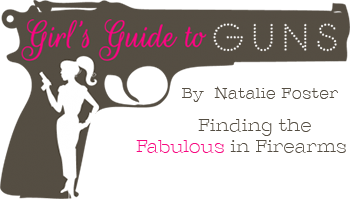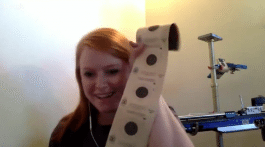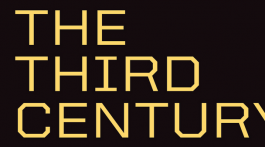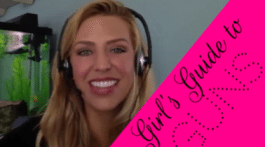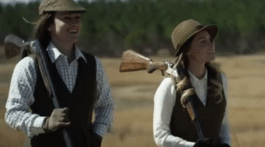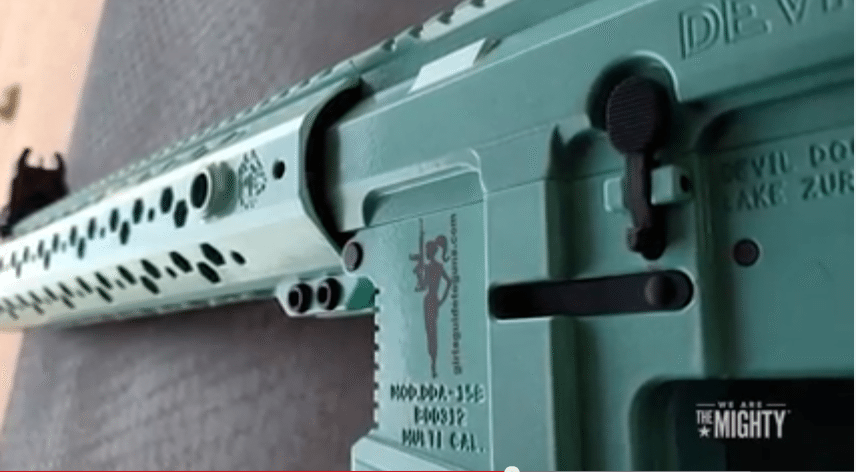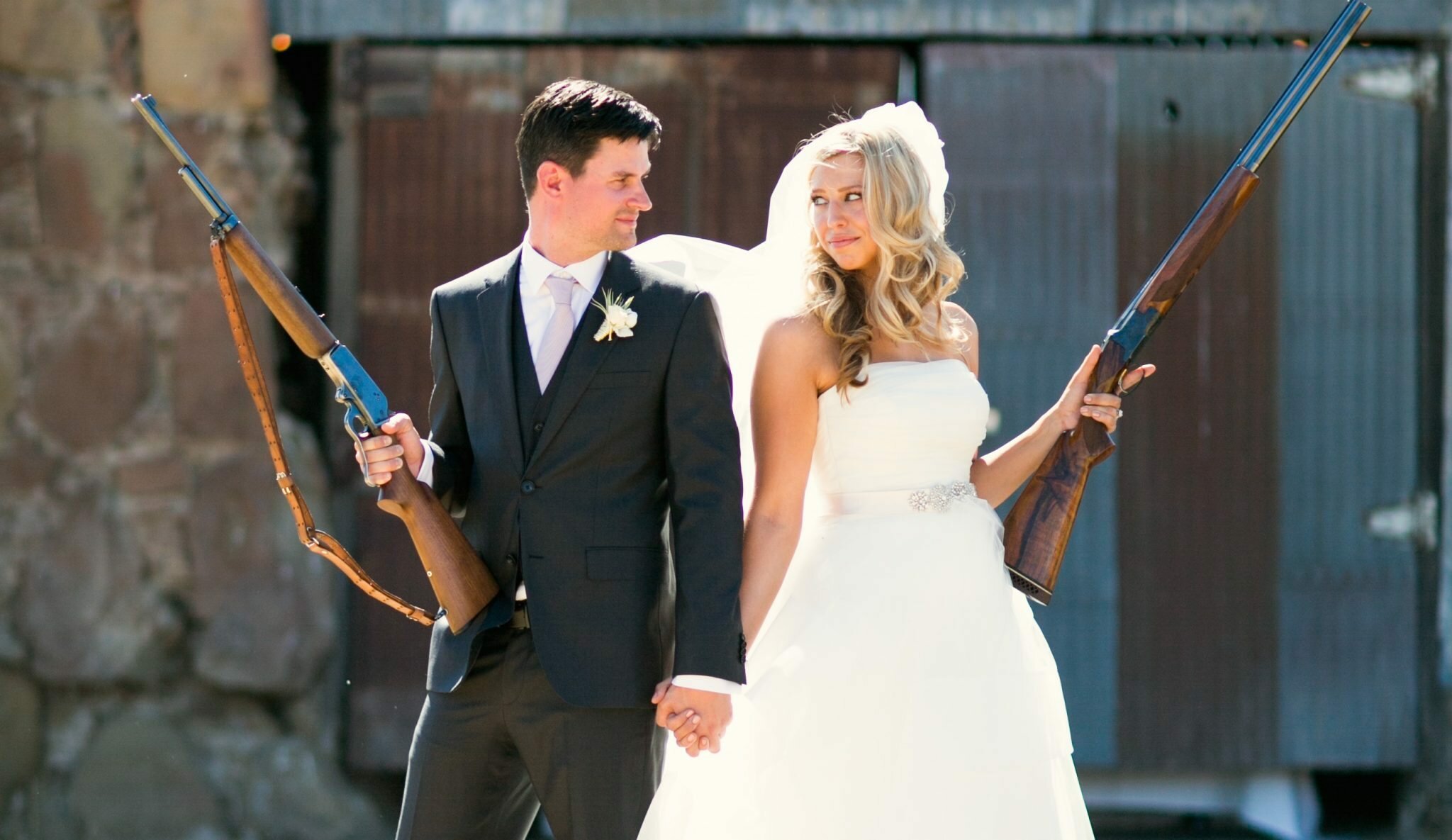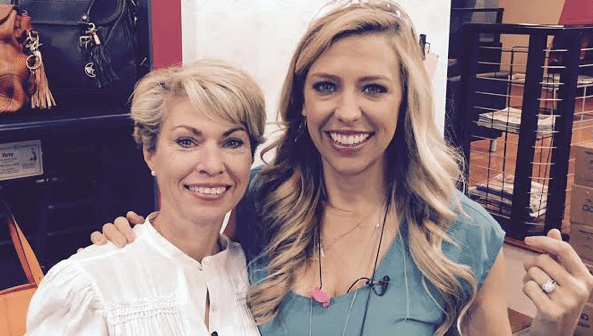We discovered OTIS at SHOT Show 2011. To tell the truth, you couldn’t really miss them. They had more amazing signs than any other company and by far the best booth at the show. I remember thinking, “Wow, that company must be doing pretty well.” When I learned that the founder and owner of OTIS was female, I was even more intrigued. Doreen Garrett generously took some time out of her busy schedule to chat with me about the history of her company and what firearms and hunting mean to her. As you’ll see below, I got much more than I bargained for. To say that Doreen is an inspiring and innovative lady doesn’t do her justice. Check out her story below:
Natalie Foster: Tell me how you got involved in the world of firearms.
Doreen Garrett: Well, I’m the oldest of four children and my dad would take me hunting with him. I think my mom just wanted to get me out of the house as a teenager {laughs}. We hunt in northern New York and the snow is usually pretty deep and I had my great grandmother’s firearm, actually. I was hunting with my dad out in the Tug Hill Plateau and I’m short and I fell in the mud and snow and I had all this junk in the end of my barrel. I had nothing with me there to get it out so I had to walk all the way back to hunting camp in my nice electric socks because I’m kind of a fair weather hunter {laughs}. I was upset that I had to walk back to the hunting camp and there was nothing there. My father came back and I said, “How do you get this stuff out of the gun?” I, of course, did something really stupid and put a stick up the end of the barrel because I thought I could dig it out. That was probably not the smartest thing to do. I ended up going home and looking through some gun junk, so to speak, that my mother had inherited from my grandfather. He was in WWII 10th Mountain Division and they were always in the snow. I’ve done a lot of research on it now, but they had a device called a ‘thong’ and it was a chain with a weight on the end of it that they carried around in the field. They’d drop that down from the breech out the end of the barrel to take out obstructions. So I started carrying that in a shoe polish tin when I was hunting. My dad’s buddies were all like, “Wow, that’ s kind of a cool thing – something to take with you.” I was a junior in high school at the time. I loved engineering. I wanted to be a draftsman. My dad had a company that had a woman draftsman at it and I would apprentice under her during the summers and that summer I designed components that would mimic what that drop-through chain with the weight on it would do. I asked my dad to take me to the SHOT Show in 1985 – he was going to look for business for his company because he made little widgets for the archery industry and different things. I talked him in to letting me go and do some market research and see if my concept was viable. I got a 10 x 10 booth at the 1985 SHOT Show and I got to the door and they wouldn’t let me in {laughs} because I was not 18. I was 16 at the time and I remember them stopping me and going, “Where are you going little lady?” And I said, “Um, to my booth,” and they said, “No you’re not, you have to be 18 to get in the show.” So my mother came to the rescue and we went back up to the hotel room and – it was the 80s – the hair went higher and the heels went on and there was lots of makeup and I walked back in to the show. So that was my first SHOT Show in 1985 – I had 8 prototypes at that show and ended up with two orders from two of the worlds largest distributors at the time. They each ordered 500 units, I think. My dad came back to the booth and said, “How ya doing?” I said, “We’ve gotta make these things!” {laughs} I went home and hired two or three friends from my high school and we started making gun cleaning kits on the kitchen table. That was 27 years ago now, so it’s been an interesting road. It was challenging being young in a male dominated industry. I think more so age, now, than gender, as the industry has grown and there are more women now playing roles in our industry. It’s kind of refreshing; and I’ve had the opportunity over the last 27 years to see and witness that change. But for me it’s always been an age thing: “Oh, when I turn 25 they’ll listen to me or when I turn 30 they’ll take me seriously.” Then when I hit 40 and realized that sometimes maybe it wasn’t about age and that it might be about gender {laughs}. But I was very fortunate, too, to have parents that always told me and my siblings that there’s nothing that you can not do. So I think sometimes, you know, having that motivation is important.
NF: That story is incredible! It’s so inspiring! It also speaks so much to what women can do when they put their minds to it. So when did OTIS become the OTIS of today?
 DG: {laughs} Over 27 years of hard work it became the OTIS of today. I did develop the mission statement that the company still lives by back in 1985. It’s just about setting goals and making a quality product that you can stand behind and that doesn’t fail in the field. The product – the quality and the customer service and everything that our mission statement stands for – is what has allowed our company to grow to what it is today. We’ve been very blessed in growing this company. Sometimes little quirky things happen that you would not want to go through, but if you don’t go through those challenges growing a business then you don’t become the business person that you are. Take every learning experience as, “Well, okay, we won’t do that again.” And go forward. I would say the change really came when we started doing military shows back in the late ’90s because some of the Marines were buying our kits from LL Bean. We private labeled for LL Bean back early on for their high quality gun cleaning kits that were compact enough. At one of the shows, the Marines came to us and said, “We would like for OTIS to develop cleaning kits for each specific weapon.” So we did that and we were being used by the Special Ops and the Marines. And then when 2001 came around and we went into theater and people in NATO and the US Army saw what Special Ops had there was a snowball effect on our military contracting and our long term contracts. That really has bolstered the growth of the company over the last 10 years as being a defense contractor. And I’m proud to say that next week we’ll be going to Columbus to receive the Gold Award for 100 percent on-time delivery and quality for the US Military, which is not achieved by many vendors. We’re proud to be on the front lines with the men and women. We have Ft. Drum right here in our back yard – our 10th Mountain Division where the President of the United States is visiting as we speak. And we have a lot of guys that will come back and visit the assembly line and the factory and thank the women for making the high quality product that may have saved their life. It gets very emotional but I think it’s also what drives us to come to work every day because we know that that product going out the door might save a soldier’s life. And it might be someone’s father or brother or mother that is going to depend on that product working. So the value proposition in that market is very very strong and we take it very seriously. And then all of our other markets like law enforcement and border patrol and our commercial market receive that same benefit because that product is of the same quality.
DG: {laughs} Over 27 years of hard work it became the OTIS of today. I did develop the mission statement that the company still lives by back in 1985. It’s just about setting goals and making a quality product that you can stand behind and that doesn’t fail in the field. The product – the quality and the customer service and everything that our mission statement stands for – is what has allowed our company to grow to what it is today. We’ve been very blessed in growing this company. Sometimes little quirky things happen that you would not want to go through, but if you don’t go through those challenges growing a business then you don’t become the business person that you are. Take every learning experience as, “Well, okay, we won’t do that again.” And go forward. I would say the change really came when we started doing military shows back in the late ’90s because some of the Marines were buying our kits from LL Bean. We private labeled for LL Bean back early on for their high quality gun cleaning kits that were compact enough. At one of the shows, the Marines came to us and said, “We would like for OTIS to develop cleaning kits for each specific weapon.” So we did that and we were being used by the Special Ops and the Marines. And then when 2001 came around and we went into theater and people in NATO and the US Army saw what Special Ops had there was a snowball effect on our military contracting and our long term contracts. That really has bolstered the growth of the company over the last 10 years as being a defense contractor. And I’m proud to say that next week we’ll be going to Columbus to receive the Gold Award for 100 percent on-time delivery and quality for the US Military, which is not achieved by many vendors. We’re proud to be on the front lines with the men and women. We have Ft. Drum right here in our back yard – our 10th Mountain Division where the President of the United States is visiting as we speak. And we have a lot of guys that will come back and visit the assembly line and the factory and thank the women for making the high quality product that may have saved their life. It gets very emotional but I think it’s also what drives us to come to work every day because we know that that product going out the door might save a soldier’s life. And it might be someone’s father or brother or mother that is going to depend on that product working. So the value proposition in that market is very very strong and we take it very seriously. And then all of our other markets like law enforcement and border patrol and our commercial market receive that same benefit because that product is of the same quality.
NF: Wow. I’m in awe. Your stories are so amazing and it’s incredible, too, to hear how you care so much about your products and how they really do affect people’s lives – and literally save some in some cases. It’s pretty profound, I think.
DG: It is and it always amazes me now how many lives we’ve touched and how many people I meet out and about who thank the company and the family for doing what we do. You know, that’s all we do – gun cleaning. And we take it very seriously. I think if you have a niche and you do something better than anyone else can… not that you can guarantee success… but you have that niche and you build upon it.
NF: You started out with your grandmother’s gun – that’s not something a whole lot of women can say. So were guns kind of a legacy in your family?
DG: You know, I didn’t think of it back then or even now, but I guess I was always around when my dad would bring the guns back from hunting and he would clean them. People invest in guns today because they know they can hand them down to their children and in some instances it won’t disappear like money in the bank. They do appreciate and become valuable. I think the maintenance aspect of taking care of those heritage-type items, to be able to hand them down to the next generation, is sometimes just as important because I think for most people, at least for a lot of people in the industry, their fondest memories are hunting with their grandfather or dad. So any time they pull that gun out of the safe they’re reminiscing about those times, so the gun becomes something special. It was a unique experience to have my grandmother’s gun to be able to hunt and, you know, maybe she was looking over me that day. {laughs}
NF: So do you remember your first time shooting? Who taught you?
DG: My dad. Yep, I remember because my father is very adamant about safety and learning experiences and so the first time I shot a gun it was at a watermelon. We all shot a watermelon off a fence post. And it was made to be very scary because he wanted us to know that guns can be dangerous if not used properly. Just like you would teach your kid to drive a car and tell them that a car can be dangerous if not used properly. So we shot the watermelon and it blew up and he said, “That’s what happens to someone’s head if you shoot them.” So you get that fear and that respect for what that tool does. We’re very adamant and have taught hundreds of kids through the Eddie Eagle program: “Stop, don’t touch, leave the area, tell an adult.” I think safety is one of the aspects that is almost incorporated in to OTIS‘s products because you have to clean breech to muzzle so you are always opening the receiver. You’re never able to clean a loaded firearm, so there’s a lot of built-in safety to our cleaning kit. And with the bore reflector, you know, you teach someone that they should always have the bore reflector in so when you’re at a distance you have a visual that the gun is safe, it’s unloaded, you don’t have to guess. There’s just a lot of different safety aspects that I think are very important for shooters in general. And sometimes the people that become the most confident are the most dangerous.
NF: You referenced the soldiers thanking the ladies. What percentage of the employees at OTIS is female?
DG: We are at 75% female.
NF: Wow- I’ve never heard of any company, especially a firearms company, being 75% female. That’s really fantastic.
DG: Yeah, well, we obviously hire based on skill but we also have assembly workers that dominate our work force. We also have a corporate day care, so many of the teachers in the day care are women.
NF: OTIS sounds like a pretty cool company to work for. Now, I know that you sponsor lots of different shooters, namely, of course, our friend Kim Rhode. How did all of that come about and why did you choose her?
DG: It’s an interesting story and it goes way back to me getting Kim’s autograph at an NRA show when she was 14 and just starting the sport, and looking at her as being able to be the face of female shooters who are young in our industry. At the time I felt like I was kind of alone out there, so when she won that gold medal it was just kind of a reiteration of, “We’re here and we’re ready to make our mark.” So we have a lot in common. We’ve talked about it before – about being so young when we started in this industry and how that affects how you work almost harder at something because you’re there to prove the world wrong. That it can be done. But, yeah, it’s just great. And when we had the opportunity to sponsor her and the means to do it, it was a no-brainer. I love being able to shoot with her and she’s just a great mentor and she just has all the same qualities culturally that OTIS has. You know, just being humble, and she’s just a great great role model for the shooting industry, and we’re very proud to be able to sponsor her. We, of course, wish her much luck in the 2012 games. I’m so impressed that she’s already qualified. It’s just really really cool and I’m proud to say that I’m a friend of hers.
NF: She really is an impressive person. Okay, so it’s probably been a little bit difficult to keep things girlie in the gun world. Do you find that that’s the case or do you do your own thing?
DF: I do my own thing. I love wearing my stilettos to work. I love pink guns. I like to find camo that fits. I love the opportunity to have something in common with my husband that we can do together after our kids are long gone out of the nest. I just have so many great memories and experiences around hunting. Whether it’s a successful harvest or not – just being outdoors in general. And I love being a girl, too. I love being girlie. I think you can have the best of both worlds and I’ve met a lot of women over time that are just, you know, you would never think they would be proficient at shooting or hunting and they’re some of the best. And you know, you can walk out in an evening gown at night and feel just as comfortable and confident walking out in your camo the next morning. I think it’s important to have those different roles because as women, you know, we do have to multitask. We are, you know, mothers, wives, sisters… we have our jobs. And to be able to go in and out of those roles and feel comfortable – each one is important to a person as a whole. So, you know, I don’t feel bad about putting on red lipstick when I go out to hunt. {laughs} You know, it’s just being who you are.
NF: I think that’s fantastic. It’s so important not to lose that sense of being girlie and feminine and it’s so great to hear such a leader in the industry express that. It’s amazing. You’re really paving the way. It’s inspiring for me, too, you know. Sometimes you do feel like it’s completely taken over by the guys and we’re here to make women feel more comfortable getting involved.
Lastly, what advice would you give women who have never shot before? They might be just dabbling their toes in the water or thinking about it – what would you say?
DG: To get a good mentor or join a woman that is involved. There are a lot of great organizations out there – Babes with Bullets is a great one for pistol shooting. We run our employees through it and offer it to them. It’s just, you know, not only empowering and educating, but even if you never want to shoot again at least you know how to handle a firearm because it is the lack of education and the fear of it that is what makes it scary. And you know, for most people who get into it, be careful because you will have a new addiction. {laughs} Beware because you’re gonna be spending some money and you’re gonna get in to it. Women do that, when we get into something we need to learn everything about it and we want all the gear. And we’re very good at shooting and any shooter out there will tell you that. There’s just so much you can do, like the Cowboy Action, and there are so many fun things you can do other than hunting. And at OTIS we really have to remember that because when you are at a trade show there are a lot of shooters out there who don’t necessarily hunt. So whether it be extreme shooting or something like skeet like Kim would do. Or like Cowboy Action – you can still have fun with a gun and not hunt. You have to remember that you can be anti-hunting but still love to shoot guns and do target shooting. I think that’s somewhat of a misnomer out there – that if you have guns then you must kill stuff. No {laughs}. You know, I love to shoot first and foremost. Hunting is a passion of mine, but even if I never hunted a day in my life, I would shoot.
